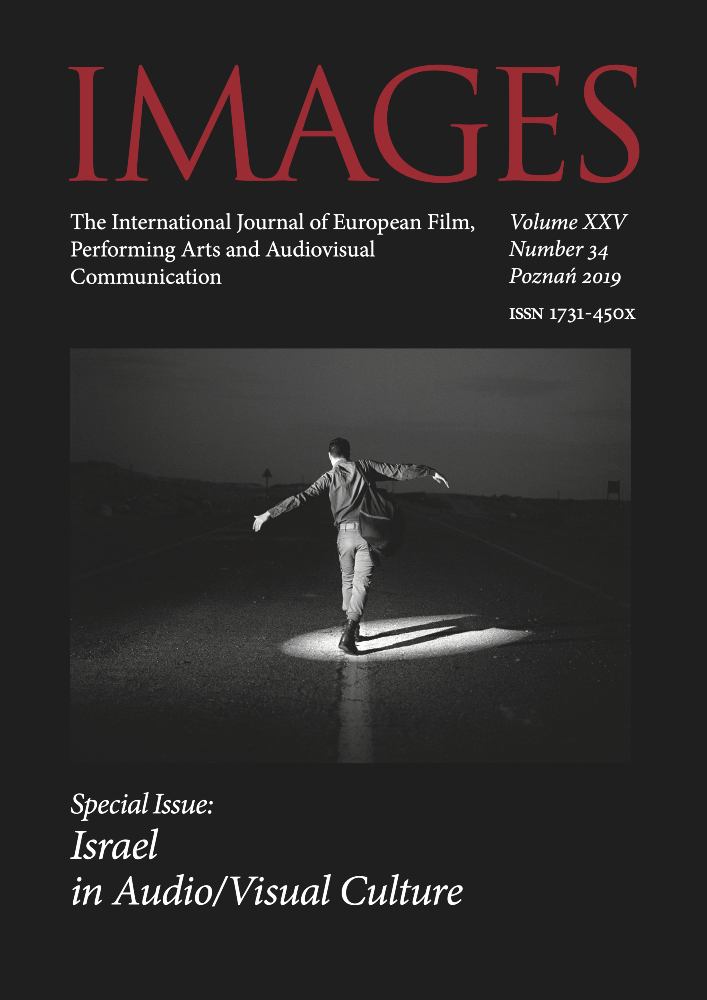Abstrakt
Abstract. Orgad Zvi, Synagogue paintings as indicating a developing conception of national redemption. “Images” vol. XXV, no. 34. Poznań 2019. Adam Mickiewicz University Press. Pp. 15–27. ISSN 1731-450X. DOI 10.14746/i.2019.34.01.
This article compares the interior paintings in the ‘Ades and Ohel Moshe synagogues, both of which are non-Ashkenazi, in the Naḥlaot neighborhood in Jerusalem. Although the synagogues were decorated 50 years apart, there are similarities in the painted motifs and drawing schemes, but also some differences. I suggest that these differences reflect the development of a Jewish concept of national redemption during the 50 years that elapsed between the adornment of the two synagogues.
Bibliografia
Amar A., Habet Hashamaima: Ẓiyurey HaKir Bayeshiva Hagdola Me’a She’arim [Look at the Sky: The Wall Paintings in the Mea Shearim Great Yeshiva], “Eretz Yisrael: Meḥkarim Biydiat Haaretz Va’atikoteha” [“The Land of Israel: Archaeological, Historical and Geographical Studies”] 2009, 28, pp. 6–38 [Hebrew]
Ariel Y., Hamikdash Oro Shel Olam [The Temple – The Light of the World], Jerusalem 2017 [Hebrew]
Azari M., Ḥag Ha’atsmaut Vehitpatḥuto Beyisrael [Independence Day and Its Development in Israel], Tel Aviv 1994 [Hebrew]
Efrati N., Ha’edah Hasefaradit Biyerushalayim: 600–677 (1840–1917) [The Sephardi Community in Jerusalem During the Years 1840–1917], Jerusalem 1999 [Hebrew]
Farkash S., Rabbi Levi Yiẓḥak Bak – Haẓayar Mehair Haatika [Rabbi Levi Yitzhak Bak – The Painter from the Old City], Lod 2002 [manuscript, Hebrew]
Feldman N., Cur., Souvenirs from The Holy Land: Meir Rosin, 1876–1917, Jerusalem 2009
Fishof I., El Mul Pney Hamenora: Amanut Yehudit Baet Haḥadasha [In Front of the Menorah: Jewish Art in the Modern Period], [in:] Leor Hamenorah: Gilgulo shel Semel [In the Light of the Menorah: a Transformation of a Symbol], ed. Y. Israeli, Jerusalem 1998, pp. 113–119 [Hebrew]
Gispan-Grinberg T., Amanut Kir Beḥadrei Okhel Bekibuẓey ‘Hakibuẓ Haarẓi,’ 1950–1967 [Murals in Dining Halls of Ha-Kibbutz Ha-Artzi, 1950–1967], “Cathedra: Letoldot Ereẓ Israel Veyishuva [For the History of Ereẓ Israel and Its Inhabitation]” 2010, no. 135, pp. 149–180 [Hebrew]
Goldman I., Batsheva, Ze’ev Raban: A Hebrew Symbolist, Tel Aviv 2001
Hamazalot [The Zodiac Signs], <http://www.palyam.org/About_us/displaySOHarticle?name= תולזמה id=th00056&bl=b00056a> [accessed: May 9, 2018]
Herzl T., Medinat Hayehudim [The Jews’ State], Tel Aviv 2008 [Hebrew]
Hildesheimer M., Galut Vegeula Bemishnato shel Rabbi Eliyahu Gutmakher [Exile and Redemption in Rabbi Eliyahu Gutmacher’s Doctrine], [in:] Mea Shnot Ẓiyonut Datit: Ishim Veshitot [100 years of Religious Zionism: Figures and Methods], eds A. Sagi, D. Schwarz, Jerusalem 2002/2003, pp. 79–96 [Hebrew]
Huberman I., Living Symbols: Symbols in Jewish Art and Tradition, [n.p.] 1988
Huberman I., Tikrot Meẓuyarot Bevatei Kneset Me’eẓ Bedrom-Mizraḥ Polin [Painted Ceilings in Wooden Synagogues in Southeastern Poland], M.A. diss., Tel Aviv University 1979 [Hebrew]
Idel M., Hamazalot Bemaḥshevet Yisrael [The Zodiac Signs in Jewish Thought], [in:] Ḥatum Bakokhavim: Dimuy Vesemel Begalgal Hamazalot [Image and Symbol in the Zodiac Cycle], ed. I. Fishof, Jerusalem 1998, pp. 19–21 [Hebrew]
Noy D., Yud Bet Hamazalot Veyud Bet Hashvatim [The Twelve Zodiac Signs and the Twelve Tribes], “Maḥanayim” 1963, 4, no. 90, pp. 128–133 [Hebrew]
Piechotka K., Piechotka M., Heaven’s Gates: Wooden Synagogues in the Territories of the Former Polish-Lithuanian Commonwealth, Warsaw 2004
Rodov I., Ẓiyurei Kir Bevatei Knesset: Masoret Mizraḥ Eiropit Beereẓ Yisrael [Wall Paintings in Synagogues: Eastern European Tradition in the Land of Israel], Ramat Gan 2011 [Hebrew]
Sabar S., Ketubbah: The Art of the Jewish Marriage Contract, Jerusalem 2000
Sefer Yeẓira [Book of Creation], Mantova: Yaakov Kohen from Glasgow, 1562
Shalev-Kahlifa N., Barnet K., Ẓiyurei Kir Bezika Lemoreshet Leumit [Wall Paintings in Association with National Heritage], p. 21 <http://www.wallart.org.il/wp-content/uploads/wall-art-as-national-heritage.pdf>, [accessed: December 19, 2018] [Hebrew]
Shalev-Kahlifa N., Naḥlaot Belev Ir: Lesayer im Yad Ben Ẓvi Beyerushalaim [Naḥlaot in the Heart of Town: Exploring Jerusalem with Yad Ben Ẓvi], Jerusalem 2003 [Hebrew]
Shalom G., Magen David: Toldotav shel Semel [The Shield of David: The Evolution of a Symbol], Ein Harod 2008 [Hebrew]
Synagogue in Bychawa: Interior, Wall Paintings, <http://cja.huji.ac.il/browser.php?mode=set&id=1070&sort=DESC&many=20&start=20> [accessed: May 15, 2018]
Synagogue in Niebylec – Interior – Wall frieze detail, <http://cja.huji.ac.il/wpc/browser.php?mode=alone&id=10480> [accessed: May 15, 2018]
Willenberg S., Mered Betreblinka [A Revolt in Treblinka], Tel Aviv 1986 [Hebrew]
Ẓalmona Y., Boris Shaẓ: Avi Haamanut Hayisraelit [Boris Shaẓ: The Father of Israeli Art], Jerusalem 2006 [Hebrew]
Ẓalmona Y., Shilo-Kohen N., Signon Veikonografia Beḥefẓey ‘Beẓalel’ [Style and Iconography in ‘Beẓalel’ Objects]”, [in:] “Beẓalel” shel Shaẓ, 1906–1929 [Shaẓ`s Beẓalel, 1906–1929], ed. N. Shilo Kohen, Jerusalem 1992/1993, pp. 201–232 [Hebrew]
Zangelevitz S., Aman Haotiyot Haivriyot [The Artist of Hebrew Letters], “Et-Mol” 2001, 26, no. 6 (158), pp. 27–28 [Hebrew]
Zenner W.P., A Global Community: The Jews from Aleppo, Syria, Detroit 2000
Zohar Z., Halakha Vehagut Eẓel Ḥakhmey Yisrael Bamizraḥ Hatikhon [The Luminous Face of the East: Studies in the Legal and Religious Thought of Sepharadic Rabbis in the Middle East], Tel Aviv 2001 [Hebrew]
Licencja

Utwór dostępny jest na licencji Creative Commons Uznanie autorstwa – Użycie niekomercyjne – Bez utworów zależnych 4.0 Międzynarodowe.
